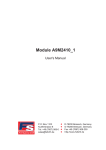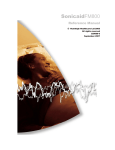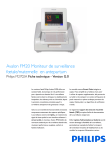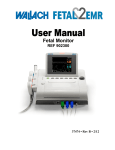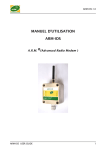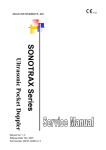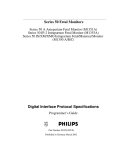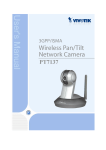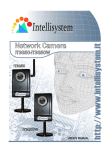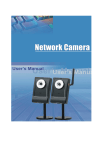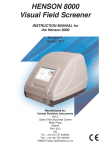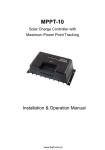Download Manual
Transcript
About this Manual P/N: 01.54.107782-15 Release Date: Apr. 2012 © Copyright EDAN INSTRUMENTS, INC. 2008 - 2012. All rights reserved. Statement This manual will help you understand the operation and maintenance of the product better. It is reminded that the product shall be used strictly complying with this manual. User’s operation failing to comply with this manual may result in malfunction or accident for which Edan Instruments, Inc. (hereinafter called EDAN) can not be held liable. EDAN owns the copyrights of this manual. Without prior written consent of EDAN, any materials contained in this manual shall not be photocopied, reproduced or translated into other languages. Materials protected by the copyright law, including but not limited to confidential information such as technical information and patent information are contained in this manual, the user shall not disclose such information to any irrelevant third party. The user shall understand that nothing in this manual grants him, expressly or implicitly, any right or license to use any of the intellectual properties of EDAN. EDAN holds the rights to modify, update, and ultimately explain this manual. Responsibility of the Manufacturer EDAN only considers itself responsible for any effect on safety, reliability and performance of the equipment if: Assembly operations, extensions, re-adjustments, modifications or repairs are carried out by persons authorized by EDAN, and The electrical installation of the relevant room complies with national standards, and The instrument is used in accordance with the instructions for use. Upon request, EDAN may provide, with compensation, necessary circuit diagrams, and other information to help qualified technician to maintain and repair some parts, which EDAN may define as user serviceable. I Using This Label Guide This guide is designed to give key concepts on safety precautions. WARNING A WARNING label advises against certain actions or situations that could result in personal injury or death. CAUTION A CAUTION label advises against actions or situations that could damage equipment, produce inaccurate data, or invalidate a procedure. NOTE A NOTE provides useful information regarding a function or a procedure. II Table of Contents Chapter 1 Warranty and Service............................................................................................ 1 Chapter 2 Overview ................................................................................................................. 4 2.1 Introduction ................................................................................................................... 4 2.2 General Information ...................................................................................................... 4 2.3 Safety Precautions ......................................................................................................... 5 Chapter 3 Installation .............................................................................................................. 8 3.1 Environment Requirements........................................................................................... 8 3.2 Electrical Requirements ................................................................................................ 9 3.3 Safety Requirements ..................................................................................................... 9 3.4 Installing the Monitor.................................................................................................... 9 3.4.1 Installing the Monitor on a Flat Surface.............................................................. 9 3.4.2 Mounting the Monitor on a Wall....................................................................... 10 3.4.3 Installing the Monitor on a Roll Stand/Trolley ................................................. 11 3.5 Connecting to AC Power............................................................................................. 11 Chapter 4 Functional Checks................................................................................................ 12 4.1 Switching on Check .................................................................................................... 12 4.2 LCD Screen Check...................................................................................................... 12 4.3 Keys Check ................................................................................................................. 12 4.4 Touch Screen Check.................................................................................................... 12 4.5 Printing Check............................................................................................................. 13 4.6 Alarms Check.............................................................................................................. 13 Chapter 5 System Configuration .......................................................................................... 14 5.1 Opening System Setup Menu...................................................................................... 14 5.2 Entering Demo Mode .................................................................................................. 14 5.3 Reloading Default Settings.......................................................................................... 14 5.4 Clearing Data............................................................................................................... 15 5.5 Checking Product Information .................................................................................... 15 5.6 Calibrating Touch Screen............................................................................................ 15 5.7 Changing the Device No. ............................................................................................ 16 5.8 Changing Net Version................................................................................................. 16 5.9 Configuring 485 Wireless Network ............................................................................ 17 5.10 Configuring for Ethernet Connecting........................................................................ 18 5.11 Changing Trace Width .............................................................................................. 18 5.12 Changing Paper Style ................................................................................................ 18 5.13 Changing the Language............................................................................................. 19 5.14 Changing FHR Algorithm......................................................................................... 19 Chapter 6 Maintenance ......................................................................................................... 20 6.1 Maintenance Inspection............................................................................................... 20 6.2 Maintenance of the Monitor........................................................................................ 21 6.3 Maintenance of the Transducers ................................................................................. 21 6.4 Maintenance of the Recorder ...................................................................................... 21 Chapter 7 Principle Introduction ......................................................................................... 23 7.1 System Principle Block Diagram ................................................................................ 23 7.1.1 Main Control Board .......................................................................................... 23 7.1.2 Fetal Monitor Module ....................................................................................... 24 III 7.1.3 DECG Module................................................................................................... 26 7.1.4 ECG (E3) Module ............................................................................................. 26 7.1.5 NIBP (V6) Module............................................................................................ 27 7.1.6 SpO2 (A6) Module ............................................................................................ 27 7.1.7 Print Controlling Board..................................................................................... 28 7.1.8 Power Interface Board....................................................................................... 30 7.1.9 Power Module ................................................................................................... 30 7.1.10 Key Board ....................................................................................................... 31 7.1.11 Bottom Interfaces Board ................................................................................. 31 7.1.12 LVDS LCD ..................................................................................................... 35 7.2 Interfaces ..................................................................................................................... 36 7.2.1 DB9/D-Sub Interface......................................................................................... 36 7.2.2 RJ45 Interface ................................................................................................... 36 7.2.3 Antenna ............................................................................................................. 36 Chapter 8 Troubleshooting ................................................................................................... 37 8.1 Monitor Booting Failures ............................................................................................ 37 8.2 Display Failures........................................................................................................... 38 8.3 Touch Screen Failures................................................................................................. 38 8.4 Operation Failures ....................................................................................................... 39 8.5 Recorder Failures ........................................................................................................ 39 8.6 Network Failures ......................................................................................................... 40 8.7 Alarm Failures............................................................................................................. 40 8.8 Technique Alarms ....................................................................................................... 40 8.9 FHR/TOCO Monitoring Failures ................................................................................ 41 8.10 DECG/IUP Monitoring Failures ............................................................................... 42 8.11 ECG Monitoring Failures.......................................................................................... 42 8.12 SpO2 Monitoring Failures ......................................................................................... 42 8.13 NIBP Monitoring Failures......................................................................................... 43 8.14 TEMP Monitoring Failures ....................................................................................... 43 Chapter 9 Modules’ Malfunction Verification .................................................................... 44 9.1 Verifying Malfunction of the Main Control Board..................................................... 44 9.2 Verifying Malfunction of the FM Module .................................................................. 46 9.3 Verifying Malfunction of the DECG Module ............................................................. 48 9.4 Verifying Malfunction of the NIBP Module............................................................... 49 9.5 Verifying Malfunction of the SpO2 Module ............................................................... 51 9.6 Verifying Malfunction of the ECG Module................................................................ 52 9.7 Verifying Malfunction of the Power Module.............................................................. 53 Chapter 10 Disassembling the Monitor................................................................................ 54 10.1 Tools Required .......................................................................................................... 54 10.2 Replacing Fuses......................................................................................................... 54 10.3 Disassembling the Main Unit.................................................................................... 55 10.4 Disassembling the Lower assembly .......................................................................... 56 10.4.1 Replacing the FM Module............................................................................... 56 10.4.2 Replacing the DECG Module ......................................................................... 57 10.4.3 Replacing the Print Controlling Board............................................................ 57 10.4.4 Replacing the Gear Assembly ......................................................................... 58 10.4.5 Replacing the Speaker..................................................................................... 59 10.4.6 Replacing the Power Module .......................................................................... 59 10.4.7 Replacing the Fan............................................................................................ 60 IV 10.4.8 Replacing the Power Interface Board.............................................................. 61 10.4.9 Replacing the NIBP Module ........................................................................... 61 10.4.10 Replacing the SpO2 Module.......................................................................... 62 10.4.11 Replacing the ECG Module .......................................................................... 63 10.4.12 Replacing the Bottom Interface Board.......................................................... 64 10.4.13 Replacing the Printhead ................................................................................ 64 10.5 Disassembling the Upper Assembly ......................................................................... 67 10.5.1 Replacing the Main Control Board ................................................................. 67 10.5.2 Replacing the Touch Screen Controlling Board ............................................. 67 10.5.3 Replacing the Key Board ................................................................................ 68 10.5.4 Replacing the Power Inverter Board ............................................................... 68 10.5.5 Replacing the LCD.......................................................................................... 69 Chapter 11 Periodic Tests...................................................................................................... 72 11.1 Safety Tests ............................................................................................................... 72 11.2 Performance Tests ..................................................................................................... 72 11.2.1 FHR Performance Test.................................................................................... 72 11.2.2 TOCO Performance Test................................................................................. 73 11.2.3 ECG Performance Test.................................................................................... 74 11.2.4 SpO2 Performance Test ................................................................................... 74 11.2.5 NIBP Performance Test .................................................................................. 75 11.2.6 TEMP Performance Test................................................................................. 75 Appendix 1 Renewal Parts .................................................................................................... 76 Appendix 2 Connecting to OB TraceVue System ............................................................... 77 V F9, F9 Express Fetal & Maternal Monitor Service Manual Warranty and Service Chapter 1 Warranty and Service Standard Service EDAN provides a one-year-warranty for the warranted products (accessories are included). The warranty period begins on the date the products are shipped to customers. If a customer promptly notifies EDAN of customer’s warranty claim hereunder, EDAN will either repair, adjust or replace (with new or exchange replacement parts) EDAN’s products. EDAN warrants that any service it provides to customers will be performed by trained individuals in a workmanlike manner. Limitation of Warranty Direct, indirect or final damage and delay caused by the following situations for which EDAN is not responsible may void the warranty: Groupware is dismounted, stretched or redebugged. Unauthorized modification or misuse. Damage caused by operating beyond the environmental specifications for the medical product. Change or remove original serial number label or Manufacturer symbol. Improper use. Service Procedure (1) Fill in the Service Claim Form (SCF). Fill in the SCF with detailed information including: Model Name, Serial Number (SN) and Problem Phenomena. EDAN should not have any obligation to take over the case without this information. The form can be downloaded at: http://www.edan.com.cn or obtained from EDAN’s Service Department. (2) Send EDAN the SCF and Select a Solution. Once the service department receives the fully filled SCF, EDAN’s engineer will offer a solution in three working days. EDAN will follow out the case based on the two conditions below: -1- F9, F9 Express Fetal & Maternal Monitor Service Manual Warranty and Service Within Warranty: There are two options: i) After receiving the Return Material Authorization (RMA) form from EDAN service department, the customer sends EDAN the defective parts and informs about the shipment tracking number. Then we will dispatch new part(s) to your confirmed address with confirmed shipping invoice. ii) The customer signs the Declaration Form and sends it back by email or fax. This form is legally certificated to make sure the customer or end-user will return the defective parts to EDAN on time. We will, at this option, dispatch the replacement one(s) with confirmed shipping invoice. NOTE: 1 Both Return Material Authorization Form and Declaration Form are offered by EDAN service department once the SCF is confirmed by service engineer. 2 The customer is responsible for freight & insurance charges when the equipment is shipped to EDAN for service, including custom charges. EDAN is responsible for the freight, insurance & custom charges from EDAN to the customer. Out of Warranty: After receiving the RMA form from the service department, the customer sends defective parts to EDAN in advance. We will analyze the problems and discuss with the customer about either repairing or replacing the part(s). Once the maintenance fee is invoiced and paid, we will make sure to dispatch good part(s) to the confirmed address. NOTE: The customer is responsible for any freight & insurance charge for the returned product. (3) Obtain the RMA Form. Before the shipment of the materials, the customer must obtain an RMA form from our service department, in which the RMA number, description of returning parts and shipping instructions are included. The RMA number should be indicated on the outside of the shipping container. -2- F9, F9 Express Fetal & Maternal Monitor Service Manual Warranty and Service NOTE: EDAN should not have any obligation to the end-user or customer who returns the goods without the notification by EDAN’s service department. The sender takes full responsibility for the accounted fee. (4) Send the Parts to EDAN. Follow these recommended instructions: Please disassemble the parts with anti-static facility, do not touch the parts with naked hand. Please pack the parts safely before return. Please put the RMA number on the parcel. Please describe the returned parts as ‘sample of *****’ and put the total value on the invoice, and note on the invoice as ‘sample, no commercial value’. Please confirm the invoice with EDAN before shipment. Please send back the parts after EDAN’s confirmation. Contact Information If you have any question about maintenance, technical specifications or malfunctions of devices, do not hesitate to contact us. EDAN Instruments, Inc. TEL: +86-755-26898321, 26899221 FAX: +86-755-26882223, 26898330 E-mail: [email protected] -3- F9, F9 Express Fetal & Maternal Monitor Service Manual Overview Chapter 2 Overview NOTE: This service manual is written to cover the maximum configuration. Therefore, your model may not have some of the parameters/modules described, depending on what you have ordered. 2.1 Introduction This service manual is a reference for periodic preventive maintenance and corrective service procedures for the F9 and F9 Express fetal & maternal monitor. It provides troubleshooting information, assembly procedures, instructions for functional testing and performance verification. It is intended for use only by technically qualified service personnel. WARNING When performing a service procedure, follow the instructions exactly as presented in this manual. Failure to do so might damage the monitor, invalidate the product warranty or lead to serious personal injury. 2.2 General Information F9, F9 Express Fetal & Maternal Monitors (hereinafter called F9, F9 Express) are designed to comply with the international safety requirements IEC/EN 60601-1 for medical electrical equipment. It is class I equipment. The protective degree against electric shock of the patient connections is: Ultrasound (FHR1, FHR2) External TOCO Intrauterine Pressure (IUP) Fetal Movement Mark (FM) Fetal Stimulator ((FS) Type BF Non-invasive Blood Pressure (NIBP) Arterial Oxygen Saturation (SpO2) Type BF, defibrillation-proof Direct Electrocardiography (DECG) Type CF -4- F9, F9 Express Fetal & Maternal Monitor Service Manual Electrocardiography (ECG) Temperature (TEMP) Overview Type CF, defibrillation-proof The monitor described in this user manual is not protected against: The effects of high frequency currents The interference of electrosurgery equipment 2.3 Safety Precautions WARNING and CAUTION messages must be observed. To avoid the possibility of injury, observe the following precautions during the maintaining the instrument. WARNING 1 F9, F9 Express must be serviced by authorized and qualified personnel only. EDAN do not accept responsibility for safety compliance, reliability and performance if modifications or repairs are carried out by unauthorized personnel. Identical replacement parts must be used. 2 The service personnel should be familiar with the operation of this monitor. Refer to User Manual of the monitor for details. 3 EXPLOSION HAZARD - Do not use the monitor in the presence of flammable anesthetics or other materials. 4 SHOCK HAZARD - the power receptacle must be a three-wire grounded outlet. Never try to adapt the three-prong plug to fit a two-slot outlet. A hospital grade outlet is required. If the outlet has only two slots, make sure that it is replaced with a three-slot grounded outlet before attempting to operate the monitor. 5 Any non-medical equipment (such as the external printer) is not allowed to be used within the patient vicinity (1.5m/6ft.). 6 Do not use the additional multiple portable socket-outlet or extension cord in the medical electrical system, unless it’s specified as part of the system by manufacturer. And the multiple portable socket-outlets provided with the system shall only be used for supplying power to equipment which is intended to form part of the system. 7 If multiple instruments are connected to a patient, the sum of the leakage currents may exceed the limits given in the IEC/EN 60601-1 and may pose a safety hazard. Consult your service personnel. 8 Multiple portable socket-outlets shall not be placed on the floor. -5- F9, F9 Express Fetal & Maternal Monitor Service Manual Overview WARNING 9 Make sure that the power is turned off and the power cord is disconnected from the AC socket before connecting or disconnecting equipment. Otherwise, the patient or operator may receive electrical shock or other injury. 10 Do not connect any equipment or accessories that are not approved by the manufacturer or that are not IEC 60601-1 approved to the monitor. The operation or use of non-approved equipment or accessories with the monitor is not tested or supported, and monitor operation and safety are not guaranteed. 11 SHOCK HAZARD - Don’t connect non-medical electrical equipment, which has been supplied as a part of the system, directly to the wall outlet when the non-medical equipment is intended to be supplied by a multiple portable socket-outlet with an isolation transformer. 12 SHOCK HAZARD - Don’t connect electrical equipment, which has not been supplied as a part of the system, to the multiple portable socket-outlets supplying the system. 13 Do not use the additional multiple portable socket-outlet or extension cord in the medical electrical system, unless it’s specified as part of the system by manufacturer. And the multiple portable socket-outlets provided with the system shall only be used for supplying power to equipment which is intended to form part of the system. 14 Do not exceed the maximum permitted load when using multiple portable socket-outlets to supply the system. 15 Do not touch accessible parts of non-medical electrical equipment and the patient simultaneously. 16 Do not switch on the monitor until all cables have been properly connected and verified. 17 Do not touch the signal input or output connector and the patient simultaneously. 18 Equipment and devices that connect to the monitor should form an equipotential body to ensure effective grounding. 19 Disconnect the power cord before changing fuses. Replace them with those of the same specifications only. 20 SHOCK HAZARD - Do not attempt to connect or disconnect a power cord with wet hands. Make certain that your hands are clean and dry before touching a power cord. 21 SHOCK HAZARD - Do not remove the top panel cover during operation or while power is connected. -6- F9, F9 Express Fetal & Maternal Monitor Service Manual Overview WARNING 22 Only connect accessories supplied or recommended by the manufacturer to the device. 23 Accessory equipment connected to the analog and digital interfaces must be certified according to the respective IEC/EN standards (e.g. IEC/EN 60950 for data processing equipment and IEC/EN 60601-1 for medical equipment). Furthermore all configurations shall comply with the valid version of the system standard IEC/EN 60601-1-1. Anybody who connects additional equipment to the signal input connector or signal output connector to configure a medical system must ensure that the system complies with the requirements of the valid version of the system standard IEC/EN 60601-1-1. If in doubt, consult our technical service department or your local distributor. 24 Parts and accessories used must meet the requirements of the applicable IEC 601 series safety standards, and/or the system configuration must meet the requirements of the IEC 60601-1-1 medical electrical systems standard. 25 Connect the grounding wire to the equipotential grounding terminal in the main system. If it is not evident from the instrument specifications whether a particular instrument combination is hazardous or not, for example due to summation of leakage currents, you should consult the manufacturer or an expert in the field, to ensure that the necessary safety of all instruments concerned will not be impaired by the proposed combination. 26 Electromagnetic Interference - Ensure that the environment in which the monitor is installed is not subject to any source of strong electromagnetic interference, such as CT, radio transmitters, mobile phone base stations, etc. 27 When installing the unit into a cabinet, allow for adequate ventilation, accessibility for servicing, and room for adequate visualization and operation. 28 Keep the environment clean. Avoid vibration. Keep it far from corrosive medicine, dust area, high-temperature and humid environment. -7- F9, F9 Express Fetal & Maternal Monitor Service Manual Installation Chapter 3 Installation WARNING Only qualified service engineers should install this equipment. 3.1 Environment Requirements Working Environment Temperature: +5 ºC ~ +40 ºC ( +41ºF ~ +104ºF) Relative Humidity: 25% ~ 80% (non-condensing) Atmospheric Pressure: 860hPa ~ 1060hPa Transport and Storage Temperature: -20 ºC ~ +55 ºC (-4ºF ~ +131 ºF) Relative Humidity: 25% ~ 93% (non-condensing) Atmospheric Pressure: 700hPa ~ 1060hPa Classification Anti-electric Shock Type: Class I equipment with internal power supply FHR1, FHR2, TOCO, IUP, FM Anti-electric Shock Degree: Degree of Protection Harmful Ingress of Water: against BF SpO2, NIBP BF (Defibrillating-proof) DECG ECG, TEMP CF CF (Defibrillating-proof) Main Unit: Ordinary equipment (sealed equipment without liquid proof) Wired US/TOCO Transducers: IPX8 Other Accessories: No liquid ingress protection Degree of Safety in Presence of Flammable Gases: Equipment not suitable for use in presence of flammable gases Disinfection/Sterilizing Method: Refer to User Manual for details EMC: Group I Class A Working System Continuous running equipment -8- F9, F9 Express Fetal & Maternal Monitor Service Manual Installation If the monitor is installed in a cabinet, allow at least 2 inches (5 cm) clearance around the monitor for proper air circulation; allow adequate accessibility for servicing, and adequate room for visualization and operation. Ensure the monitor is not subject to any source of strong electromagnetic interference, such as CT, radio transmitters, mobile phones base stations, etc. Do not install the monitor in a flammable atmosphere where concentrations of flammable anesthetics or other materials may occur. Keep the environment clean. Avoid vibration. Keep it far from corrosive medicine, dust area, high-temperature and humid environment. 3.2 Electrical Requirements Operating Voltage: Operating Frequency: Input Power: Battery: 100V-240V ~ 50Hz/60Hz 110VA 14.8V/4400mAh 3.3 Safety Requirements SHOCK HAZARD- The power receptacle must be a three-wire grounded outlet. A hospital grade outlet is required. Never adapt the three-prong plug from the monitor to fit a two-slot outlet. If the outlet has only two slots, make sure that it is replaced with a three-slot grounded outlet before attempting to operate the monitor. Do not touch signal input or output connector and the patient simultaneously. Equipment and devices that connect to the monitor should form an equipotential body to ensure effective grounding. Do not switch on the monitor until all cables have been properly connected and verified. 3.4 Installing the Monitor 3.4.1 Installing the Monitor on a Flat Surface. Place the monitor on a flat surface. Make sure the surface does not vibrate, and is free of corrosive medicine and dust. -9- F9, F9 Express Fetal & Maternal Monitor Service Manual Installation 3.4.2 Mounting the Monitor on a Wall To mount the monitor on a wall, 1 Order a wall mounting board (01.52.107983) and a connecting board (01.52.107984) from the manufacturer. 2 Turn the monitor over and fix the connecting board to the bottom panel using two pan head screws. WALL Figure 3-1 Fixing Connecting Board Figure 3-2 Fixing Wall Mounting Board 3 Fix the wall mounting board to the wall with six self-tapping screws. 4 Lift the monitor with the bottom panel facing the wall. Let the four posts on the board stretch into wall-mounting holes and then release your hands from the monitor slowly. 5 Secure the connecting board to the wall mounting board with a pan head screw. Figure 3-3 Securing Two Boards - 10 - F9, F9 Express Fetal & Maternal Monitor Service Manual Installation CAUTION 1 The monitor should only be mounted on a solid concrete or brick wall. 2 Shut the display completely flat before mounting the monitor to the wall. 3 Make sure the wall mounting board is firmly fixed to the wall. If there is any doubt, do not hang the monitor to this board. 4 Make sure the monitor is safely hung on the posts of the board before releasing your hands from the monitor. 3.4.3 Installing the Monitor on a Roll Stand/Trolley An Assembling Instruction will be delivered with the roll stand/trolley. Refer to that instruction for details of installing the monitor on a roll stand/trolley. Figure 3-4 The Monitor on a Trolley (Sketch Map) 3.5 Connecting to AC Power Apply the power cable provided with the monitor. Plug one end of the power cable to the power socket of the monitor. Connect the other end to a grounded 3-slot power output special for hospital usage. - 11 - F9, F9 Express Fetal & Maternal Monitor Service Manual Functional Checks Chapter 4 Functional Checks This section describes the procedure of a complete functional test to support recommended preventive-maintenance schedules. You are not required to open the device case for functional checks. WARNING Only qualified service personnel should perform a full functional check procedure. Whenever the monitor is serviced or problems are suspected, the manufacturer recommends a full functional check procedure. 4.1 Switching on Check Press the POWER switch on the right panel to switch on the monitor. Check if the power indicator lights up, if a start-up tone is heard, and if the screen lights up in a few seconds. If any failure is detected, refer to section 8.1 Monitor Booting Failures for details. 4.2 LCD Screen Check Observe if some characters are missing, or if there are bright spots and dark shadows on the LCD screen. Observe if the waveforms, fonts and symbols displayed on the LCD screen are normal. If any failure is detected, refer to section 8.1 Monitor Booting Failures for details. 4.3 Keys Check Press the keys on the front panel to check if they work properly. When pressing a key, a normal key tone should be heard, unless its related function is disabled. If any failure is detected, refer to section 8.2 Display Failures for details. 4.4 Touch Screen Check When the monitor is configured with a touch screen, touch any available keys on the screen to check if the screen is working properly. - 12 - F9, F9 Express Fetal & Maternal Monitor Service Manual Functional Checks If you touch the center of a key but the monitor does not execute the right operation, calibrate the touch screen. Refer to section 5.5 Calibrating Touch Screen for details. If any operation failure is detected, refer to section 8.3 Touch Screen Failures for details. 4.5 Printing Check Press the PRINT key to start printing. Check if the recorder starts printing. Enable the Print Self-Test function. Restart the monitor and verify if the recorder prints a baseline. Enter DEMO mode and print some traces and check if all the traces are clear on the paper. If any failure is detected, refer to section 8.5 Recorder Failures for details. NOTE: Please make sure the paper loading and setting are correct before the printing starts. 4.6 Alarms Check Stimulate a signal that is higher than the upper limit or lower than the lower limit to activate a physical alarm. Disconnect one of the plugs off the monitor to activate a technical alarm. Check if the audible alarms and visible alarms are working properly. If any failure is detected, refer to section 8.7 Alarm Failures for defective details. - 13 - F9, F9 Express Fetal & Maternal Monitor Service Manual System Configuration Chapter 5 System Configuration The end users can not change the system configurations of the monitor. As a service engineer, you need to change these configurations for them after the monitor is installed and checked properly. NOTE: Restart the monitor after changing the settings. 5.1 Opening System Setup Menu The system configurations of the monitor are to be changed in the system setup menu. To open this menu, 1 Select the setup key on the main interface. 2 Select System. 3 Input the password 9999 on the soft keyboard. 4 Select Enter on the soft keyboard. 5.2 Entering Demo Mode The monitor works in real-time monitoring mode when monitoring a patient. If you want to show the traces and parameters for a demonstration, you need to enter the Demo mode. 1 Open the System Setup menu. 2 Select Demo. 3 Select OK. 5.3 Reloading Default Settings The default settings are predefined in the factory. Users can change the monitor setup, but this default configuration stays the same. To reload this default, 1 Open the System Setup menu. 2 Select Default. 3 Select OK. - 14 - F9, F9 Express Fetal & Maternal Monitor Service Manual System Configuration 5.4 Clearing Data The auto-saved data is saved in the monitor memory. In order to delete this data, 1 Open the System Setup menu. 2 Select Clear Data. 3 Select OK. 5.5 Checking Product Information The product information menu lists the hardware and software information of this monitor. This information can be very helpful when contacting the manufacturer for service. To check the product information, 1 Open the System Setup menu. 2 Select Product Information. 5.6 Calibrating Touch Screen NOTE: Make sure the touch screen is enabled before trying to open the touch screen calibration menu. When the monitor does not react to each touch on the touch screen properly, calibrate the touch screen by performing the following steps: 1 Open the System Setup menu. 2 Select Touch Screen Calibration. 3 Touch the cross mark “ ” on the screen successively. This menu is closed when calibration finishes. - 15 - F9, F9 Express Fetal & Maternal Monitor Service Manual System Configuration 5.7 Changing the Device No. This device No. determines the bedside monitor ID on the data receiving software, such as MFM-CNS central monitoring system of EDAN. 1 Open the System Setup menu. 2 Select Network Setup. 3 Select the pane next to Device No.. 4 Select a device number from 1 ~ 99. 5 Select OK in the Network Setup menu. 6 Select OK in the System Setup menu. CAUTION Make sure the device numbers of the monitors in the same system do not overlap. 5.8 Changing Net Version This Net version determines the network protocol of monitor when it is connecting to a PC. Connecting Mode Other Requirements F9 connects to MFM-CNS via DB9 interface. MFM-CNS version is V3.0 or higher MFM-CNS version is V3.3 or higher MFM-CNS version is V3.7 or higher - 16 - Net Version RS485 V1.1 RS485 V1.2 RS485 V1.3 F9, F9 Express Fetal & Maternal Monitor Service Manual System Configuration F9 connects to Insight software via DB9 interface. --- INSIGHT V1.2 F9 connects to MFM-CNS or Insight software via Ethernet. MFM-CNS version is V3.4 or higher ETHERNET V1.2 F9 connects to MFM-CNS or Insight software via Wi-Fi wireless network. MFM-CNS version is V3.4 or higher ETHERNET V1.3 F9 connects to OB TraceVue system of PHILIPS. --- PHILIPS F9 connects to FetalCare system. --- FetalCare F9 connects to QS system. --- QS --- MILOU-RS232 --- MILOU-ETHERNET F9 connects to MILOU system via DB9 interface. F9 connects to MILOU system via Ethernet. 1 Open the System Setup menu. 2 Select Network Setup. 3 Select the pane next to Net Version. 4 Select a net version. 5 Select OK in the Network Setup menu. 6 Select OK in the System Setup menu. 5.9 Configuring 485 Wireless Network When connecting the monitor to MFM-CNS via 485 wireless network, you need to set wireless channel number and wireless module number: 1 Open the System Setup menu. 2 Select Network Setup. 3 Select Wireless CH. 4 Select a number (6 ~ 31). 5 Select Wireless MOD. 6 Select a number (0 ~ 31). 7 Select OK in the Network Setup menu. 8 Select OK in the System Setup menu. - 17 - F9, F9 Express Fetal & Maternal Monitor Service Manual System Configuration NOTE: Refer to MFM-CNS Wireless Network Installation Guide for details of setting 485 wireless network. 5.10 Configuring for Ethernet Connecting When connecting the monitor to a PC via Ethernet, you need to set the server IP and Ethernet port: 1 Open the System Setup menu. 2 Select Network Setup. 3 Select Server IP. 4 Set the IP address to be the same as that of the PC. 5 Select Ethernet Port. 6 Set the port number to be the same as that of the software. 7 Select OK in the Network Setup menu. 8 Select OK in the System Setup menu. 5.11 Changing Trace Width In order to differentiate the traces clearly, you may assign different widths for different traces. 1 Open the System Setup menu. 2 Select Recorder Setup. 3 Select FHR1. 4 Select a number from 1, 2, 3 and 4. The width of the trace increases by degrees from 1 to 4. 5 Set width of FHR2, AFM, TOCO, HR and SpO2 traces in the same way. 6 Select OK in the Recorder Setup menu. 7 Select OK in the System Setup menu. 5.12 Changing Paper Style The paper style determines the range of FHR trace background pane bar. Observe the recorder paper that the user has ordered, 30 ~ 240 is USA style; 50 ~ 210 is International style. 1 Open the System Setup menu. 2 Select Recorder Setup. - 18 - F9, F9 Express Fetal & Maternal Monitor Service Manual System Configuration 3 Select the pane next to Paper Style. 4 Select the required style from USA and International. 5 Select OK in the Recorder Setup menu. 6 Select OK in the System Setup menu. CAUTION To avoid inconsistency between FHR traces on the recorder paper and those on the screen, the paper style must comply with the style of the recorder paper being used. 5.13 Changing the Language The software supports several languages. 1 Open the System Setup menu. 2 Select Language. 3 Select the required language. 4 Select OK. 5.14 Changing FHR Algorithm The Beat-to-beat FHR algorithm provides vivid short-term variation information of the fetal heart rate. The Average FHR algorithm provides a smoothened FHR trace. 1 Open the System Setup menu. 2 Select Beat-to-beat or Average. 3 Select OK. - 19 - F9, F9 Express Fetal & Maternal Monitor Service Manual Maintenance Chapter 6 Maintenance 6.1 Maintenance Inspection (1) Visual Inspection Check the monitor and accessories to see if there is any visible damage that may affect patient’s safety. Check all the outer cables, power socket and power cables. Check if the monitor functions properly. If any damage is detected, replace the damage part(s) or contact EDAN immediately. (2) Routine Inspection The overall check of the monitor, including the safety check and functional check, should be performed by qualified personnel every 6 to 12 months, and each time after service. The equipment should undergo periodic safety test to insure proper patient isolation from live parts. This should include leakage current measurement and insulation testing. The recommended testing interval is once a year or as specified in the institution’s test and inspection protocol. Patient Leakage Current (Limit) Patient Auxiliary Current (Limit) N.C. d.c. 10µA a.c. 10µA S.F.C. 50µA 50µA N.C. 10µA 10µA N.C. 10µA 10µA N.C. 10µA 100µA N.C. 10µA 10µA N.C. 10µA 100µA S.F.C. 50µA 50µA S.F.C. 50µA 50µA S.F.C. 50µA 500µA S.F.C. 50µA 50µA S.F.C. 50µA 500µA d.c. a.c. Patient Leakage Current (Limit) (CF applied part) Patient Leakage Current (Limit) (BF applied part) Patient Auxiliary Current (Limit) (CF applied part) Patient Auxiliary Current (Limit) (BF applied part) - 20 - d.c. a.c. d.c. a.c. d.c. a.c. d.c. a.c. F9, F9 Express Fetal & Maternal Monitor Service Manual Maintenance (3) Mechanical Inspection Make sure all exposed screws are tightly fixed. Check the external cables for splits, cracks or signs of twisting. Pay particular attention to the supply socket. Replace any cable that shows serious damage. 6.2 Maintenance of the Monitor Keep the exterior surface of the monitor clean, free of dust and dirt. The gathering of dew on the screen may occur with abrupt temperature or humidity changes. A table environment is recommended. Do not scratch or damage the screen. Avoid high voltage and static charge. 6.3 Maintenance of the Transducers Keep the transducers in a dry environment with the temperature lower than +45°C (+113°F). Wipe off coupling gel from the ultrasound transducer after use to prolong its life. Handle the transducers with care. Rough handling could damage the cover, piezoelectric crystals and mechanical movement. Contacting the transducers with hard or sharp objects should be avoided. Do not excessively flex the cables. 6.4 Maintenance of the Recorder The recorder platen, thermal printhead and paper sensing mechanism must be cleaned at least once a year or when needed (when traces become faint). To clean the recorder: 1) Clean the recorder platen with a lint-free cloth dampened in soap/water solution. 2) Wipe the thermal array using a cotton swab moistened with 70% Isopropyl alcohol-based solution. 3) Remove the dust from the paper sensing mechanism and paper sensor with a dry clean cloth. - 21 - F9, F9 Express Fetal & Maternal Monitor Service Manual Maintenance CAUTION Only use the recorder paper provided by EDAN, or it may damage the recorder. This kind of damage is not covered by warranty. - 22 - F9, F9 Express Fetal & Maternal Monitor Service Manual Principle Introduction Chapter 7 Principle Introduction 7.1 System Principle Block Diagram F9 monitor consists of the main control board, fetal monitor (FM) module, DECG module, print board, power module, key board, LCD and the corresponding interface boards. Besides that, F9 Express includes NIBP module, SpO2 module and ECG module. Here is the system principle block diagram: Figure 7-1 System principle block diagram 7.1.1 Main Control Board The main control board applied is the 2410 main control board. It fulfills the following function: key input control, LCD display, process print, audio alarm and led indicate light alarm, data - 23 - F9, F9 Express Fetal & Maternal Monitor Service Manual Principle Introduction memory and recall, time and date management, communication with the internal modules, ect. The parameters of this main control board are listed below: Power 5V, 12V Processor S3C2410A Work frequency: 266MHz / 200MHz External bus frequency: 1/2 or 1/4 of main frequency Dictate Cache: 16K bytes Data Cache: 16K bytes Net Port 10M Standard Ethernet port Parallel Port 1 parallel port, with CENTRONIX subclass interface definition EMS Memory SDRAM: 64M byte Flash: program 8M bytes + data 64M bytes Serial Port Configure in 5 serial ports and 9 serial ports way Headphone Interface Loudspeaker output Touch Screen Interface 1 interface. USB 1 standard USB HOST interface, 1 standard DEVICE interface (1.1 specification) VGA 1 VGA output port LCD 1 TFT LCD interface, 1024*768 (highest resolution) Keyboard 1 PS/2 keyboard interface GPIO At least 10 Watchdog Timer 1.6s Power Consumption 700mA @ +5V (max) Size 142 mm×105 mm Operating System Linux 7.1.2 Fetal Monitor Module The main function of the fetal monitor module is to detect FHR, AFM and TOCO, and a new function of collecting and playing back audio signals is added. As shown in figure 3, power, simulating front circuit, ADC, audio processing circuit and digital circuit are included. Signal detecting is divided into three branches: two fetal hearts and fetal movements detecting and one for TOCO (pressure on the pregnant woman’s abdomen) detecting. - 24 - F9, F9 Express Fetal & Maternal Monitor Service Manual Figure 7-2 Fetal monitor module circuit block diagram - 25 - Principle Introduction F9, F9 Express Fetal & Maternal Monitor Service Manual Principle Introduction 7.1.3 DECG Module The DECG module fulfills the function of DECG detecting, TOCO and intrauterine pressure measuring, and then send the results to the main control board through serial port. 7.1.4 ECG (E3) Module The ECG module includes ECG monitoring part and TEMP monitoring part. Their specifications are listed as follows: (1) ECG Lead Mode 3 Leads (R, L, F or RA, LA, LL), Lead Selection I, II, III, drive leads change accordingly Waveform 1 channel Measurement Range 30 bpm ~ 240 bpm Accuracy + 1% or +1 bpm, whichever is larger Resolution 1 bpm Sensitivity > 200 µV (peak to peak) Differential Input Impedance ≥ 5 MΩ Defibrillator Protection Yes ESU Protection None (2) TEMP Channel Qty. 1 Measurement Range 0 ºC ~ +50.0 ºC Resolution 0.1 ºC Accuracy +25 ºC ~ +45 ºC: 0 ºC ~ +25 ºC, +45 ºC ~ +50 ºC: Sensor Type YSI (B series) and CF-FI Update Time Every 1 ~ 2 second(s) Self-test Every 5 ~ 10 minutes - 26 - ±0.1 ºC ±0.2 ºC F9, F9 Express Fetal & Maternal Monitor Service Manual Principle Introduction 7.1.5 NIBP (V6) Module Method Oscillometric Mode Manual, Auto Circle, continuous measuring Auto Circle Mode Interval 1, 2, 3, 4, 5, 10, 15, 30, 60, 90, 120, 240, 480 minute(s) Continuous Measuring 5 minutes, 5s Interval Measuring Type Systolic Pressure, Diastolic Pressure, Mean Artery Pressure Range Systolic Pressure Range: 40 mmHg ~ 270 mmHg Diastolic Pressure Range: 10 mmHg ~ 215 mmHg Mean Artery Pressure Range: 20 mmHg ~ 235 mmHg Cuff Pressure Range 0 mmHg ~ 280 mmHg Pressure Resolution 1 mmHg Average Error ± 5 mmHg Standard Deviation ≤ 8 mmHg Cuff Autoinflation 120s Entire Measurement Period 30s ~ 45 s Overpressure Protection (297 + 3) mmHg (double overpressure protection) 7.1.6 SpO2 (A6) Module The SpO2 module consists of two parts: sensor and measuring system. The measuring system includes SpO2 signals collecting, amplified simulating circuit system and relative digital/analog converting, and signal processing systems. The pulse extent of optical signal changes during monitoring. SpO2 parameter, pulse rate signal and pleth wave will be acquired after calculation. These data will be transmitted to the position machine with special communication protocol. The specifications are listed as follows: SpO2 Measurement & Alarm Range 0% ~ 100% Resolution 1% Accuracy + 2 (70% ~ 100%) Pulse Measurement & Alarm Range 30 bpm ~ 240 bpm Resolution 1 bpm Accuracy + 3 bpm; + 5 bpm (during movement) - 27 - F9, F9 Express Fetal & Maternal Monitor Service Manual Principle Introduction 7.1.7 Print Controlling Board The print controlling board is in charge of receiving data from main control board and driving the thermosensitive printhead to print. Its structure block diagram is as follows: Figure 7-3 Print controlling board principle block diagram The recorder module includes: microprocessor AT91SAM7S256 circuit, power switch and control, communicate interface, motor control part, recorder paper detecting circuit, time control for printing power and heating, paper lacking temperature control and thermosensitive head protecting circuit. Definitions of print controlling board interfaces (1) Interface connects to bottom interface board Pin No. 1 2 3 4 5 6 7 8 9 - 28 - Symbol VDD VDD GND VCC GND TXD RXD BUSY PE F9, F9 Express Fetal & Maternal Monitor Service Manual (2) Interface connects to print head Pin No. 1 2 3 4 5 6 7 8 9 10 11 12 13 14 15 Symbol VH_+24V VH_+24V VH_+24V GND GND GND VCC THERMISTOR /STROBE_3 /STROBE_3 /STROBE_6 /STROBE_6 CLOCK /LATCH DATAIN (3) Interface connects to stepper motor (gear assembly) Pin No. 1 2 3 4 5 6 Symbol VDD_MOTOR VDD_MOTOR /B B /A A (4) Interface connects to paper sensor (paper lack detecting) Pin No. 1 2 3 - 29 - Symbol VDD_PS GND PS Principle Introduction F9, F9 Express Fetal & Maternal Monitor Service Manual Principle Introduction 7.1.8 Power Interface Board The power interface board is used to transfer the power, its circuit is: Figure 7-4 Power Interface board circuit F1 and F2 are two containers for fuses, the specification of the fuse is: T2AH250V. J1 is the equipotential grounding point that connects to the ground. J2 is a 3-pin socket for outer power input. J3 is the output port connecting to the power module in the machine. C1, C2, C3 and C4 are Y capacitors, every capacitor resists 2300V voltage. Connecting a 10 Ω resistor and two Y capacitors in series between L-PE and N-PE will improve the fetal heart and solve the data jumping problem when measuring FH with EFT. When laying out the PCB of this board, the creepage distances between L, N and PE must not be less than 8mm, the distance between L and N must not be less than 3mm. 7.1.9 Power Module The power module outputs +12V, +5V voltage and manages charging. When outer power (90-264VAC) is connected, the power module converts the alternative current into 12V and 5V direct current, providing power for monitor running and built-in battery charging. When outer power is disconnected, the power module converts the battery power into 12V and 5V direct current, providing power for monitor running. - 30 - F9, F9 Express Fetal & Maternal Monitor Service Manual Principle Introduction Figure 7-5 Power module block diagram 7.1.10 Key Board The key board codes the operation of keys and control knob with AT89C2051 singlechip processor, sends keycode to main control board using PS2 protocol, answers the corresponding keys and controls display of power indicator, AC indicator and Charge indicator. Its structure block diagram is as follows: Figure 7-6 Key board principle block diagram 7.1.11 Bottom Interfaces Board The bottom interface board consists of connect CNS interconnection circuit, voltage switching circuit, built-in wireless module power circuit and interfaces. - 31 - F9, F9 Express Fetal & Maternal Monitor Service Manual Principle Introduction Interface definition (1) Interface connects to power module Pin No. 1 2 3 4 5 6 Symbol VCC GND GND GND VDD VEE (2) Interface connects to power control board Pin No. 1 2 3 4 5 6 Symbol MB_TXD6 MB_RXD6 GND CHARGE AC_ON Reserved Pin No. 1 2 3 Symbol GND MB_RXD1 MB_TXD1 (3) Interface connects to FM board (4) Interface connects to print controlling board Pin No. 1 2 3 4 5 6 7 8 9 - 32 - Symbol +12V +12V GND VCC GND MB_RXD2 MB_TXD2 BUSY PE F9, F9 Express Fetal & Maternal Monitor Service Manual Principle Introduction (5) Interface connects to main control board Pin No. 1 2 3 4 5 6 7 8 9 10 11 12 13 14 Symbol VCC GND/BAT_V VCC GND +12V GND SOFT_CLOSE CLOSE_ASK BAT_ON CHARGE AC_ON GND ENERGY4 ENERGY3 Pin No. 15 16 17 18 19 20 21 22 23 24 25 26 27 28 Symbol ENERGY2 ENERGY1 MB_RXD0 MB_TXD0 MB_RTS GND BUSY PE GND CALL_CTRL MB_RXD2 MB_TXD2 MB_RXD1 MB_TXD1 Pin No. 29 30 31 32 33 34 35 36 37 38 39 40 Symbol MB_RXD3 MB_TXD3 MB_RXD7 MB_TXD7 USB_DATAUSB_DATA+ MB_RXD4 MB_TXD4 MB_RXD5 MB_TXD5 MB_RXD8 MB_TXD8 (6) Interface connects to DECG module Pin No. 1 2 3 4 5 - 33 - Symbol MB_RXD3 MB_TXD3 GND +12V VCC F9, F9 Express Fetal & Maternal Monitor Service Manual Principle Introduction (7) RJ45 Ethernet interface (8) USB interface Pin No. 1 2 3 4 5 6 7 8 Symbol TD+ TDRD+ Reserved Reserved RDReserved Reserved Pin No. 1 2 3 4 Symbol USB_VCC USB_DATAUSB_DATA+ GND Pin No. 1 2 3 4 5 6 7 8 9 10 11 12 13 Symbol US2 ISOCNS_RXD ISOCNS_TXD 485EN 0V Ref. TA TB RA RB DECG_SIGNAL US1 +5V TOCO Pin No. 1 2 3 4 5 6 7 8 9 Symbol ISOVCC ISOCNS_RXD ISOCNS_TXD EXT_MODEL_EN GND TA TB RA RB (9) RS232 (485 network) interface D-Sub interface: DB9 interface: - 34 - F9, F9 Express Fetal & Maternal Monitor Service Manual Principle Introduction (10) Interface connects to built-in wireless module Pin No. 1 2 3 4 Symbol WLMODE_VCC GND ISORX ISOTX Pin No. 1 2 3 4 Symbol TD+ TDRD+ RD- (11) Ethernet interface 7.1.12 LVDS LCD LCD applies a 12.1” screen with LCDS interface. Its main technical specifications are as follows: Items Unit Specifications Screen Diagonal [mm] 310 (12.1”) Active Area [mm] 246.0(H) x 184.5(V) Pixel H x V 800(x3) x 600 Pixel Pitch [mm] 0.3075(H) x 0.3075(V) Pixel Arrangement R.G.B. Vertical Stripe Display Mode Normally White [cd/m2] Typical White Luminance (ICFL= 6mA) Contrast Ratio 200 Typ. (center) 500:1 Typ. Optical Rise Time / Fall Time [msec] 10/25 Typ. Nominal Input Voltage VDD [Volt] +3.3 Typ. Typical Power Consumption (VDD line+VCFL line) [Watt] 7.8 Typ. Weight [Grams] 640 + 10 Physical Size [mm] 279.0(W) x 209.0(H) x 11(D) Electrical Interface LVDS Support Color Native 262K colors (RGB 6-bit driver) Temperature Range: Operating [°C] -10 to +65 Storage(Shipping) [°C] -30 to +70 - 35 - F9, F9 Express Fetal & Maternal Monitor Service Manual Principle Introduction 7.2 Interfaces On the rear panel of the monitor, there are two interfaces and an antenna: z DB9 interface or D-Sub interface z RJ45 interface (NETWORK) z Antenna 7.2.1 DB9/D-Sub Interface All the monitors are configured with a DB9 interface or D-Sub interface. It is used to connect the monitor to a computer for monitoring information collection (with a software such as Insight.), or to an obstetrical monitoring system such as MFM-CNS. 7.2.2 RJ45 Interface All the monitors are configured with an RJ45 interface. It is used to connect the monitor to a computer for updating or monitoring information collection (with software such as Insight.), or to an obstetrical monitoring system such as MFM-CNS. 7.2.3 Antenna If the monitor has a built-in wireless module, an antenna will be configured. It is used to send signals of the bedside monitor to the obstetrical monitoring system. - 36 - F9, F9 Express Fetal & Maternal Monitor Service Manual Troubleshooting Chapter 8 Troubleshooting This troubleshooting guide introduces the suitable actions for correcting the problems or replacing the accessory or calling the service person. It can also help you to have more exact descriptions of the fault symptoms when calling for service. EDAN supports replacement of PCBs and major subassemblies for this product. Verify the malfunction of the PCBAs/Modules prior to disassembling with the method described in chapter 9 Modules’ Malfunction Verification. When replacement is needed, follow the procedures described in chapter 10 Dissembling the Monitor. 8.1 Monitor Booting Failures Phenomenon After switching on, LCD has no display; the power indicator is off; the fan doesn’t run. Possible Cause Solution No AC mains connected. Check if the power cord is damaged. Check if the power cord is well connected to the power socket of the monitor and hospital AC outlet. The fuses are blown. Replace the fuses. Main control defective. The fuses blow when switching on the monitor. Abrupt switching off. board Replace the main control board. Power board defective. Replace the power board. Short circuit of other parts Look for the short circuit source and fix it. The monitor is stricken by strong high voltage, such as lighting strike. Check the power supply and earth system. Bad power performance. supply Replace power supply. Main control defective. board Bad connection. - 37 - Replace the main control board. Check all the connectors. F9, F9 Express Fetal & Maternal Monitor Service Manual Troubleshooting 8.2 Display Failures Phenomenon Possible Cause Solution The LCD has no display. The LCD related cable(s) is (are) disconnected. LCD defective. LCD displays characters. improper Check that the LCD related cables between the main control board, power inverter board and the LCD are well connected. Check that the LCD backlight cable is well connected. Replace the LCD. Power inverter defective. board LCD backlight defective. board Main control defective. board LCD defective. Replace the power inverter board. Replace the LCD backlight board. Replace the main control board. Replace the LCD. 8.3 Touch Screen Failures Phenomenon Possible Cause The touch disabled. The touch screen is not functioning. The touch position invalid. Solution screen is Check if the touch screen is disabled in the system setup. If yes, enable it. The touch screen related cable(s) is (are) disconnected. Check that the touch screen related cables between the main control board, touch screen controlling board and the touch screen are well connected. The touch damaged. Replace the touch screen. screen is The touch screen is not calibrated. - 38 - Calibrate the touch screen using procedures described in section 5.6 Calibrating Touch Screen. F9, F9 Express Fetal & Maternal Monitor Service Manual Troubleshooting 8.4 Operation Failures Phenomenon Possible Cause Solution Bad key board connection. Check key board wire. Key board is damaged. Replace the key board. Loudspeaker or wire has a failure. Replace the loudspeaker or the wire. Loudspeaker defective. Replace the loudspeaker. Main control defective. Replace the main control board. Keys not functioning When a key is pressed, no tone is heard. Hoarse or odd sound from loudspeaker. board 8.5 Recorder Failures Phenomenon No paper advances. Possible Cause Solution No paper in the drawer. Load paper and close the drawer. Paper drawer is open. Close the drawer. Open the drawer and remove the paper jam. Re-load paper then close the drawer. Paper jam. Print controlling defective. The “Check paper” alarm message appeared on the screen, but the drawer is not empty. Blank, blurry traces. or incorrect board Replace the print controlling board. Recorder connection failure. Check all the connectors. Gear assembly defective. Replace the gear assembly. Main control defective. Replace the main control board. board Paper sensor dirty. Clean the paper sensor with a dry clean cloth. Paper sensor defective. Replace the paper sensor. The paper drawer is not closed properly. Push the drawer back in position. Paper is loaded. Reload paper correctly. not correctly The printhead adjusting nuts are lopsided. Adjust the printhead adjusting nuts. Print head defective. Replace the printhead. Improper paper settings of the monitor. Set paper style according to section 5.12 Changing Paper Style. - 39 - F9, F9 Express Fetal & Maternal Monitor Service Manual Troubleshooting 8.6 Network Failures Phenomenon Possible Cause Solution The RS232 or Ethernet socket defective. Replace the RS232 or Ethernet socket. Bad connection between the bottom interface board and main control board. Check the connection. Main control board defective. Replace main control board. Overlapped device no. in the network. Change monitor. Incorrect sever IP setting. Set server IP correctly. Possible Cause Solution The audible alarm is temporarily disabled. Switch on the audible alarm. Loudspeaker or wire defective. Replace the loudspeaker or the wire. Alarm indicator defective. Replace alarm indicator. Alarm indicator board defective. Replace alarm indicator board. Program defective. Update the software. Phenomenon Possible Cause Solution Fetus EQUIP MALF Bad connection between FM module, bottom interface board and main control board. Check the connection. FM module defective. Replace FM module. Main control board defective. Replace main control board. The monitor can not connect to a network. device no. of the 8.7 Alarm Failures Phenomenon No audible alarm is activated. The alarm indicator stays off. No audible alarm or visual alarm is activated. 8.8 Technique Alarms - 40 - F9, F9 Express Fetal & Maternal Monitor Service Manual DECG EQUIP MALF NIBP EQUIP MALF ECG EQUIP MALF SpO2 EQUIP MALF Troubleshooting Bad connection between DECG module, bottom interface board and main control board. Check the connection. DECG board defective. Replace DECG board. Main control board defective. Replace main control board. Bad connection between NIBP module, bottom interface board and main control board. Check the connection. NIBP board defective. Replace NIBP board. Main control board defective. Replace main control board. Bad connection between ECG module, bottom interface board and main control board. Check the connection. ECG board defective. Replace ECG board. Main control board defective. Replace main control board. Bad connection between SpO2 module, bottom interface board and main control board. Check the connection. SpO2 board defective. Replace SpO2 board. Main control board defective. Replace main control board. 8.9 FHR/TOCO Monitoring Failures Phenomenon Possible Cause No FHR/TOCO numeric value. trace or Bad connection transducers. Solution of Inaccurate values. beat or no measurement Check the connection. US Transducer defective. Replace the transducer. FM module defective. Replace the FM module. Main control defective. Lower heart sound. the board Replace the main control board. Loudspeaker defective. Replace the loudspeaker. US transducer defective. Replace the US transducer. Main control defective. Replace the main control board. board FM module defective. Main control defective. - 41 - Replace the FM module. board Replace the main control board. F9, F9 Express Fetal & Maternal Monitor Service Manual Troubleshooting 8.10 DECG/IUP Monitoring Failures Phenomenon No DECG/IUP numeric value. trace or Possible Cause Solution Bad connection of cables. Check the connection. Cables defective. Replace the cables. DECG module defective. Replace the DECG module. Main control defective. Replace the main control board. board 8.11 ECG Monitoring Failures Phenomenon Possible Cause No ECG trace. Bad connection cable. Solution of ECG Cables defective. Check the connection. Replace the cables. Bad connection electrodes. of Check the connection. ECG module defective. Replace the ECG module. Main control defective. Replace the main control board. board 8.12 SpO2 Monitoring Failures Phenomenon No SpO2 waveform numeric value. or Possible Cause Solution SpO2 transducer defective. Replace the SpO2 transducer. Bad connection of SpO2 cable. Check the connection. Cables defective. Replace the cables. SpO2 module defective. Replace the SpO2 module. Main control defective. Replace the main control board. - 42 - board F9, F9 Express Fetal & Maternal Monitor Service Manual Troubleshooting 8.13 NIBP Monitoring Failures Phenomenon Possible Cause Solution Check the connection from outside. The cuff fails to be inflated. Bad connection of the cuff, the air hose and the NIBP socket. Bad connection of the NIBP module to the NIBP socket. Check the connection from inside. Cuff or extension defective. Replace the damaged part(s). No NIBP numeric values. tube NIBP module defective. Replace the NIBP module. Main control defective. Replace the main control board. board NIBP module defective. Replace the NIBP module. Main control defective. Replace the main control board. board 8.14 TEMP Monitoring Failures Phenomenon No TEMP numeric value. Possible Cause Solution TEMP transducer defective. Replace the TEMP transducer. Bad connection of TEMP transducer. Check the connection. ECG module defective. Replace the ECG module. Main control defective. Replace the main control board. - 43 - board F9, F9 Express Fetal & Maternal Monitor Service Manual Modules’ Malfunction Verification Chapter 9 Modules’ Malfunction Verification When a module is suspected of malfunction, verify it with the method described in this chapter. NOTE: For all the interfaces, the first pin is the one with a square solder pad. 9.1 Verifying Malfunction of the Main Control Board To verify the main control board, 1) Open the main unit using the procedures described in section 10.3. 2) Switch on the monitor. (Powered by AC or battery.) 3) Measure the voltage to earth of the pins listed below, using a multimeter: Item 1 ○ 2 ○ 3 ○ 4 ○ 5 ○ 6 ○ 7 ○ 8 ○ 9 ○ Pin Reference result J8’s first pin VCC+5V (5.0±5%) V J31’s first pin VCC33(3.3±5%)V TP1 +12V (12.0±5%) V TP2 PVCC(3.3±5%)V C35’s positive pole VDDARM (1.9±5%) V C16’s positive pole VDDALIVE (1.9±5%) V J2’s first pin VBB33 (3.3±5%) V C59 VDD_RTC (1.8±5%) V C61 Li_BAT (≥2.75V) Main control board 1 J8 ○ 3 TP1 ○ 4 TP2 ○ 5 C35 ○ 6 C16 ○ 7 J2 ○ 2 J31 ○ - 44 - F9, F9 Express Fetal & Maternal Monitor Service Manual J8 J31 TP1 C35 C16 J2 Modules’ Malfunction Verification TP2 Rear of the Main control board 8 C59 ○ 9 C61 ○ 4) Compare the measurement results with the reference results in the list. If any one of the results exceeds the reference range, the main control board defection is confirmed. Replacement of the main control board is recommended. - 45 - F9, F9 Express Fetal & Maternal Monitor Service Manual Modules’ Malfunction Verification 9.2 Verifying Malfunction of the FM Module To verify the FM module, 1) Open the main unit using the procedures described in section 10.3. 2) Measure the voltage to earth of the pins listed below, using a multimeter: Item Pin Reference result 1 ○ TP19 (+6±10%) V 2 ○ TP18 (+6.8±10%) V 3 ○ TP10 (+2.5±10%) V 4 ○ TP22 (-5±10%) V 5 ○ TP15 (+3.3±10%) V 6 ○ TP20 (+5±10%) V FM Module 1 TP19 ○ 2 TP18 ○ 3 TP10 ○ 4 TP22 ○ 5 TP15 ○ 6 TP20 ○ 3) Compare the measurement results with the reference results in the list. If all the results are in - 46 - F9, F9 Express Fetal & Maternal Monitor Service Manual Modules’ Malfunction Verification the allowance range. Switch on the monitor and measure the voltage to earth of the pins listed below. Item Pin Reference result ⑦ TP3 (0.45±20%) V 8 ○ 9 ○ 10 ○ 11 ○ 12 ○ 13 ○ TP13 (3.30±20%) V TP9 (0.9±20%) V TP8 (0.9±20%) V TP11 (3.30±20%) V TP2 (0.45±20%) V TP4 (0.40±20%) V ⑦ TP3 9 ○ TP9 10 ○ TP8 12 ○ 8 ○ TP13 11 ○ TP11 TP2 13 ○ TP4 4) If any one of the results exceeds the reference range, the FM module defection is confirmed. Replacement of the module is recommended. - 47 - F9, F9 Express Fetal & Maternal Monitor Service Manual Modules’ Malfunction Verification 9.3 Verifying Malfunction of the DECG Module To verify the DECG module, 1) Open the main unit using the procedures described in section 10.3. 2) Disconnect the DECG cable connector from the bottom interface board. 3) Switch on the monitor. 4) Measure the voltage to earth of the following pins on the bottom interface board, using a multimeter: Item 1 ○ 2 ○ 3 ○ Pin st 1 pin of J9 nd 2 pin of J9 th 5 pin of J9 J16 J9 J14 Reference result MB_RXD3 MB_TXD3 (+5 ±5%) V Bottom Interface Board J5 J3 5) Measure the 1 pin of J9 with an oscillograph. A 0V ~ 5V pulse string signal should be st detected. 6) If all the results are in the reference range, reconnect the DECG cable and measure the voltage to earth of the following pins on the DECG board. Item 4 ○ 5 ○ 6 ○ Pin Reference result TP7 (+3.3±5%) V TP5 (+8±5%) V TP6 (-8±5%) V - 48 - F9, F9 Express Fetal & Maternal Monitor Service Manual 7 ○ T1 (+5±5%) V 6 TP6 ○ DECG Module Modules’ Malfunction Verification 7 TP1 ○ 4 TP7 ○ 5 TP5 ○ 7) Compare the measurement results with the reference results in the list. If any one of the results exceeds the reference range, the DECG module defection is confirmed. Replacement of the module is recommended. 9.4 Verifying Malfunction of the NIBP Module To verify the NIBP module, 1) Make sure the malfunction of NIBP measurement is not caused by other defects, such as bad connection or defective cuff, extension tube, main control board, etc. 2) Open the main unit using the procedures described in section 10.3. 3) Disconnect the NIBP cable connector from the bottom interface board. 4) Switch on the monitor. 5) Measure the voltage to earth of the following pins on the bottom interface board, using a multimeter: (Refer to section 9.3 for J5’s location.) Item Pin Reference result 1 ○ 1st pin of J5 MB_RXD5 2 ○ 3rd pin of J5 MB_TXD5 - 49 - F9, F9 Express Fetal & Maternal Monitor Service Manual 3 ○ 6th pin of J5 (+5±5%) V 4 ○ 7th pin of J5 (+12±5%) V Modules’ Malfunction Verification 6) Use an oscillograph to measure the 1st pin of J5. A 0 ~5V pulse string signal should be detected. 7) If all the results are in the reference range, reconnect the NIBP plugs. Measure the following pins on the NIBP board. Item Pin Reference result 5 ○ 2nd pin of J4 (+5±5%) V 6 ○ 3rd pin of J4 (+12±5%) V 7 ○ 5th pin of J4 Serial port signal with 9600bps baud rate 8 ○ 6th pin of J4 Serial port signal with 9600bps baud rate J4 8) If any one of the results exceeds the reference range, the NIBP module defection is confirmed. Replacement of the module is recommended. - 50 - F9, F9 Express Fetal & Maternal Monitor Service Manual Modules’ Malfunction Verification 9.5 Verifying Malfunction of the SpO2 Module To verify the SpO2 module, 1) Make sure the malfunction of SpO2 measurement is not caused by other defects, such as bad connection or defective transducer, main control board, etc. 2) Open the main unit using the procedures described in section 10.3. 3) Disconnect the SpO2 cable connector from the bottom interface board. 4) Switch on the monitor. 5) Measure the voltage to earth of the following pins of the bottom interface board, using a multimeter: (Refer to section 9.3 for J14’s location.) Item Pin Reference result 1 ○ 1st pin of J14 (+12±5%) V 2 ○ 3rd pin of J14 MB_TXD4 3 ○ 4th pin of J14 MB_RXD4 4 ○ 5th, 6th pin of J14 (+5±5%) V 6) Use an oscillograph to measure the 4th pin of J14. A 0 - 5V pulse string signal should be detected. 7) If all the results are in the reference range, reconnect the SpO2 plugs. Measure the following pins on the SpO2 board. Item Pin Reference result 5 ○ 1st pin of J2 4.75V ~ 5.25V 6 ○ 3rd pin of J2 Serial port signal with 4800bps baud rate 7 ○ 4th pin of J2 Serial port signal with 4800bps baud rate - 51 - F9, F9 Express Fetal & Maternal Monitor Service Manual Modules’ Malfunction Verification J2 8) If any one of the results exceeds the reference range, the SpO2 module defection is confirmed. Replacement of the module is recommended. 9.6 Verifying Malfunction of the ECG Module To verify the ECG module, 1) Make sure the malfunction of ECG measurement is not caused by other defects, such bad connection or defective electrodes, main control board, etc. 2) Open the main unit using the procedures described in section 10.3. 3) Disconnect the ECG cable connector from the bottom interface board. 4) Switch on the monitor. 5) Measure the voltage to earth of the following pins of the bottom interface board, using a multimeter: (Refer to section 9.3 for J16’s location.) Item Pin Reference result 1 ○ 1st pin of J16 MB_RXD7 2 ○ 2nd pin of J16 MB_TXD7 3 ○ 4th pin of J 16 (+5±5%) V 6) Measure the 1st pin of J16 by using an oscillograph, a 0V ~ 5V pulse string signal should be detected. 7) If all the results are in the reference range, reconnect the ECG plugs. Measure the following pins on the ECG board. - 52 - F9, F9 Express Fetal & Maternal Monitor Service Manual Item Modules’ Malfunction Verification Pin Reference result 4 ○ 1st pin of J4 4.75V ~ 5.25V 5 ○ 3rd pin of J4 Serial port signal with 115000bps baud rate 6 ○ 4th pin of J4 Serial port signal with 115200bps baud rate J4 8) If any one of the results exceeds the reference range, the ECG module defection is confirmed. Replacement of the module is recommended. 9.7 Verifying Malfunction of the Power Module To verify the power module, 1) Open the main unit using the procedures described in section 10.3. 2) Disconnect the power board connector from the bottom interface board. 3) Switch on the monitor. 4) Measure the voltage to earth of the following pins on the bottom interface board, using a multimeter: (Refer to section 9.3 for J3’s location.) Item Pin Reference result 1 ○ 1st pin of J3 (+5±5%) V 2 ○ 5th pin of J3 (+12±5%) V 5) If any one of the results exceeds the reference range, the power module defection is confirmed. Replacement of the module is recommended. - 53 - F9, F9 Express Fetal & Maternal Monitor Service Manual Disassembling the Monitor Chapter 10 Disassembling the Monitor WARNING 1 Only qualified service personnel should open the monitor case. 2 Switch off the monitor and remove the AC power cable before disassembling the monitor. 3 After any repair of the monitor, perform safety tests before using the monitor again. 10.1 Tools Required 1 – A cross-head screwdriver 2 – A flat-head screwdriver 3 – A M3 nut driver 4 – A pair of pliers 10.2 Replacing Fuses To replace the blown fuse, 1) Switch off the monitor and unplug it. 2) Fold the LCD display completely flat. 3) Carefully place the monitor upside down on a flat surface covered with cloth or other protecting pad. 4) Place a flat-head screw driver in the gap of the fuse. Apply a certain amount of pressure on the screw driver to sink the fuse for about 1 mm. Unscrew the fuse anticlockwise. - 54 - F9, F9 Express Fetal & Maternal Monitor Service Manual Disassembling the Monitor 5) Remove the old fuse. Take out a new fuse supplied by EDAN or of the same specification: Size: Ф5mm*20mm; Model: T2AH250V. 6) Place the new fuse in the fuse socket. Press it in and screw it clockwise back in position. 10.3 Disassembling the Main Unit The main unit consists of two major parts: upper assembly and lower assembly. To disassemble the main unit, 1) Fold the LCD display completely flat. 2) Carefully place the monitor upside down on a flat surface covered with cloth or other protecting pad. 3) With a cross-head screw driver, remove the six screws securing the upper assembly to the lower assembly. 4) Hold both upper and lower assemblies together, place the monitor upright again. 5) Carefully lift up the upper assembly and place it upside down on the left side of the lower assembly. 1 2 1 – Upper assembly 3 4 2 – Network Cable 5 6 3 –Main control board Power Cable 4 – Ground Wire (connecting the upper assembly and the lower assembly) 5 –Main Control Board & Bottom Interfaces Board Connecting Cable - 55 - F9, F9 Express Fetal & Maternal Monitor Service Manual Disassembling the Monitor 6 – Lower assembly 6) Disconnect the cables/wires to separate the two parts. 10.4 Disassembling the Lower assembly 10.4.1 Replacing the FM Module To remove the FM module, 1) Separate the upper assembly and the lower assembly. 2) Remove the four screws on the FM module shield cover. 3) Disconnect all the wires. 4) Remove the studs/screw securing the FM module. To replace the FM module, Replace the FM module in a reverse procedure. Refer to the following illustration when connecting wires. Ensure they are all correctly connected. (vi) (vii) (viii) No. Connect to (i) i Toco Socket ii US2 Socket iii Bottom Interfaces Board (J18) (ii) (iii) iv US1 Socket v Mark Socket vi Speaker vii Bottom Interfaces Board (J4) viii Power Module (iv) (v) - 56 - F9, F9 Express Fetal & Maternal Monitor Service Manual Disassembling the Monitor 10.4.2 Replacing the DECG Module To remove the DECG module, 1) Separate the upper assembly and the lower assembly. 2) Disconnect all the wires. 3) Remove the four screws securing the DECG module. To replace the DECG module, Replace the DECG module in a reverse procedure. Refer to the following illustration when connecting wires. Ensure they are all correctly connected. No. (i) (ii) Connect to i Bottom Interfaces Board ii IUP Socket iii DECG Socket (iii) 10.4.3 Replacing the Print Controlling Board To remove the print controlling board, 1) Separate the upper assembly and the lower assembly. 2) Disconnect all the wires on the PCBA. 3) Remove the three screws securing the PCBA. To replace the print controlling board, Replace the print controlling board in a reverse procedure. Refer to the following illustration when connecting wires. Ensure they are all correctly connected. - 57 - F9, F9 Express Fetal & Maternal Monitor Service Manual (i) (ii) Disassembling the Monitor (iii) No. Connect to ii Paper Sensor iii Paper Drawer Detector iv Bottom Interfaces Board (iv) v Print head vi Gear Assembly (v) 10.4.4 Replacing the Gear Assembly To remove the gear assembly, 1) Separate the upper assembly and the lower assembly. 2) Disconnect the wires’ connector from the print controlling board. 3) Remove the three screws securing the gear assembly. To replace the gear assembly, Replace the gear assembly in a reverse procedure. Ensure the wires’ connector is correctly connected to the print controlling board. - 58 - F9, F9 Express Fetal & Maternal Monitor Service Manual Disassembling the Monitor 10.4.5 Replacing the Speaker To remove the speaker, 1) Separate the upper assembly and the lower assembly. 2) Unplug the speaker wires’ connector from the FM module. 3) Remove the three screws securing the speaker frame. 4) Remove the four screws securing the speaker to the frame. To replace the speaker, Replace the speaker in a reverse procedure. Ensure the wires’ connector is correctly connected to the FM module. 10.4.6 Replacing the Power Module To remove the power module, 1) Separate the upper assembly and the lower assembly. 2) Disconnect all the wires on the module. 3) Remove the four screws securing the module. To replace the power module, Replace the power module in a reverse procedure. Refer to the following illustration when connecting wires. Ensure they are all correctly connected. - 59 - F9, F9 Express Fetal & Maternal Monitor Service Manual (i) (ii) Disassembling the Monitor (iii) No. Connect to i Power Switch ii Battery Interface Board iii FM module , Print Control Board and Bottom Interface Board iv Power Interface Board v Green/Yellow Ground Wire (connects to power (iv) (v) interface board) 10.4.7 Replacing the Fan To remove the fan, 1) Separate the upper assembly and the lower assembly. 2) Unplug the fan wires connector from the power cable bundle. 3) Remove the two screws securing the fan frame. 4) Remove the four screws securing the fan to the frame. To replace the fan, Replace the fan in a reverse procedure. Ensure the wires’ connector is correctly connected to connector on the power cable bundle. - 60 - F9, F9 Express Fetal & Maternal Monitor Service Manual Disassembling the Monitor 10.4.8 Replacing the Power Interface Board To remove the power interface board, 1) Separate the upper assembly and the lower assembly. 2) Unplug the power wires connector from the power interface board. Using pliers to release the ground wire. 3) Remove the three screws securing the power interface board. To replace the power interface board, Replace the power interface board in a reverse procedure. Ensure the wires are correctly connected. No. (i) Connect to i Power Module ii Grounding Wires of the Power Module (ii) 10.4.9 Replacing the NIBP Module To remove the NIBP module, 1) Separate the upper assembly and the lower assembly. 2) Disconnect the wire connecting the module to the bottom interface board. Detach the plastic tube from the NIBP socket. 3) Remove the four screws securing the NIBP module. To replace the NIBP module, Replace the module in a reverse procedure. Ensure the wires are correctly connected. - 61 - F9, F9 Express Fetal & Maternal Monitor Service Manual Disassembling the Monitor 10.4.10 Replacing the SpO2 Module To remove the SpO2 module, 1) Separate the upper assembly and the lower assembly. 2) Disconnect all the wires on the SpO2 module. 3) Remove the two studs/screws securing the module. To replace the SpO2 module, Replace the SpO2 module in a reverse procedure. Refer to the following illustration when connecting wires. Ensure they are all correctly connected. - 62 - F9, F9 Express Fetal & Maternal Monitor Service Manual Disassembling the Monitor No. i ii (i) Connect to SpO2 Socket Bottom Interface Board (ii) 10.4.11 Replacing the ECG Module To remove the ECG module, 1) Separate the upper assembly and the lower assembly. 2) Disconnect all the wires on the ECG module. 3) Remove the two studs/screws securing the module. To replace the ECG module, Replace the ECG module in a reverse procedure. Refer to the following illustration when connecting wires. Ensure they are all correctly connected. (i) No. ( ii ) ( iii ) - 63 - Connect to i Bottom Interface Board ii TEMP Socket iii ECG Socket F9, F9 Express Fetal & Maternal Monitor Service Manual Disassembling the Monitor 10.4.12 Replacing the Bottom Interface Board To remove the bottom interface board, 1) Separate the upper assembly and the lower assembly. 2) Disconnect all the wires on the board. 3) Remove the five screws securing the board. To replace the bottom interface board, Replace the bottom interface board in a reverse procedure. Refer to the following illustration when connecting wires. Ensure they are all correctly connected. (vii) (vi) (v) (iv) (iii) ( ii) (i) No. Connect to i Network Wire ii Power Control Board iii Battery iv Signal Cable v SpO2 Module vi ECG Module vii NIBP Module viii FM Module (P2) (viii) (ix) (x) ix Print Control Board x Power Board + Fan xi FM Module (J28) (xi) 10.4.13 Replacing the Printhead To remove the printhead, 1) Separate the upper assembly and the lower assembly. 2) Loosen the FM module by removing its fixing screws. 3) Remove the DECG module. 4) Unplug the connectors of the printhead signal cable and paper sensor cable from the print control board, and then loosen the print control board by removing its fixing screws. - 64 - F9, F9 Express Fetal & Maternal Monitor Service Manual FM Module DECG Module Disassembling the Monitor Print Control Board Paper sensor cable Printhead signal cable 5) Remove the film that separates the boards and the metal piece (paper drawer cover). 6) Remove the screws ○ 3 -○ 6 , loose the screws ○ 1 -○ 2 and then rotate the metal retainers sideward to release the printhead connecting board. 1 ○ Metal retainers 2 ○ 3 ○ 4 ○ 5 ○ 6 ○ Printhead connecting board 7) Take the printhead connecting board out from the monitor and then remove the four screws that fix the printhead. - 65 - F9, F9 Express Fetal & Maternal Monitor Service Manual Disassembling the Monitor Printhead To replace the printhead, Replace the printhead in a reverse procedure. The connector of the paper sensor cable is supposed to be connected to J2 socket of the print control board. The connector of the printhead signal cable is supposed to be connected to J5 socket of the print control board. CAUTION The thermal printhead is a fragile part. Handle it with care. - 66 - F9, F9 Express Fetal & Maternal Monitor Service Manual Disassembling the Monitor 10.5 Disassembling the Upper Assembly 10.5.1 Replacing the Main Control Board To remove the main control board, 1) Separate the upper assembly and the lower assembly. 2) Disconnect all the wires on the main control board. 3) Remove the four screws securing the board. To replace the main control board, Replace the main control board in a reversal procedure. Refer to the following illustration when connecting wires. Ensure they are all correctly connected. (v) (vi) (vii) No. i Connect to… LCD Backlight Board (i) ii Power Inverter Board (ii) iii Key Board iv Alarm Indicator (iii) v Network Socket of Bottom Interface Board (iv) vi Power Module vii Bottom Interface Board viii LCD Assembly (viii) 10.5.2 Replacing the Touch Screen Controlling Board To remove the touch screen controlling board, 1) Separate the upper assembly and the lower assembly. 2) Disconnect all the wires on the touch screen controlling board. 3) Remove the four screws securing the board. To replace the touch screen controlling board, Replace the board in a reverse procedure. Refer to the following illustration when connecting - 67 - F9, F9 Express Fetal & Maternal Monitor Service Manual Disassembling the Monitor wires. Ensure they are all correctly connected. No. Connect to i Main Control Board ii Touch Screen Signal Cable (i) (ii) 10.5.3 Replacing the Key Board To remove the key board, 1) Separate the upper assembly and the lower assembly. 2) Disconnect all the wires on the key board. 3) Remove the four screws securing the board. To replace the key board, Replace the board in a reverse procedure. Refer to the following illustration when connecting wires. Ensure they are all correctly connected. (i) No. (ii) Connect to i Main Control Board ii Control Knob 10.5.4 Replacing the Power Inverter Board To remove the power inverter board, 1) Separate the upper assembly and the lower assembly. 2) Disconnect all the wires on the power inverter board. 3) Remove the four screws securing the board. To replace the power inverter board, Replace the board in a reverse procedure. Refer to the following illustration when connecting wires. Ensure they are all correctly connected. - 68 - F9, F9 Express Fetal & Maternal Monitor Service Manual (i) (ii) Disassembling the Monitor (iii) No. i Connect to LCD Backlight Wire (Short) ii Main Control Board iii LCD Backlight Wire (Long) 10.5.5 Replacing the LCD To remove the LCD, 1) Separate the upper assembly and the lower assembly. 2) Disconnect the five wires from the power inverter board, main control board and touch screen controlling board (shown with arrows). 3) Remove the four screws shown with the arrows. 4) Place the upper assembly upright. Open the display assembly completely. Remove four screws securing the display assembly stander. - 69 - F9, F9 Express Fetal & Maternal Monitor Service Manual Disassembling the Monitor Display Assembly Stander 5) Remove seven screws on the back of display assembly and the two roll shaft covers. Roll Shaft Covers 6) Pull out the wires then open the display assembly with care. 7) Remove the touch screen signal cable from the LCD. 8) Remove the six screws securing the LCD to the case. - 70 - F9, F9 Express Fetal & Maternal Monitor Service Manual Disassembling the Monitor LCD Touch screen signal cable No. i Power inverter (left) ii Power inverter (right) iii Main control board i (vi socket) v ii Connect to iv Main control board (vii socket) vi v Touch screen controller iii To replace the LCD, Replace the LCD in a reverse procedure. Refer to the following illustration when connecting wires. Ensure they are all correctly connected. - 71 - F9, F9 Express Fetal & Maternal Monitor Service Manual Periodic Tests Chapter 11 Periodic Tests 11.1 Safety Tests Safety tests should be performed by qualified personnel every 6 to 12 months, and each time after service. Use a standard safety tester to perform safety tests. The tester must comply with IEC/EN 60601-1 or the local standards and statutes. Refer to the accompanying operation instructions of the tester for test procedure details. 11.2 Performance Tests The performance test should be done once every 12 months or when you suspect the measurement is incorrect. 11.2.1 FHR Performance Test This test checks the performance of FHR measurement. Required Equipment: Ultrasonic Doppler FHR Accuracy Tester System 1) Connect the equipment and the monitor as shown below: Ultrasonic Doppler FHR Accuracy Tester Ultrasound Transducer 2) Switch on the monitor. 3) Generate the heart rate 50 bpm, 90 bpm, 120 bpm, 150 bpm, 180 bpm and 210 bpm in turn. 4) Check if the FHR value displayed on the screen is accurate. Error within 2 bpm is acceptable. 5) Connect the ultrasound transducer to the other US socket and perform the same test. - 72 - F9, F9 Express Fetal & Maternal Monitor Service Manual Periodic Tests 11.2.2 TOCO Performance Test This test checks the performance of TOCO measurement. 1) Switch on the monitor. 2) Connect the TOCO transducer to the fetal monitor. 3) Gently press the center of the transducer. 4) Check that the value on the display shows this change in pressure. 5) Lay the transducer face up on a hard, flat surface for a few seconds. 6) Press the AUTO ZERO key to zero the TOCO displays 10. 7) Find a flat thing, such as a coin, whose diameter is less than 2.7cm. 8) Turn the transducer over so that the transducer is resting on the coin. The TOCO numeric should read between 35 and 50. TOCO display = 10±2 TOCO display = 35 ~ 50 A Coin ø < 2.7cm The Coin If a TOCO transducer fails the test, repeat this test with another transducer. If the second one passes the test, defect of the first transducer is confirmed. Replace it with a good one. If the second transducer fails the test as well, check the monitor. - 73 - F9, F9 Express Fetal & Maternal Monitor Service Manual Periodic Tests 11.2.3 ECG Performance Test This test checks the performance of ECG measurement. Required Equipment: ECG Simulator 1) Connect the equipment and the monitor as shown below: 3-Lead ECG Cable ECG Simulator 2) Switch on the monitor. 3) Generate the heart rate 40 bpm, 80 bpm, 120 bpm, 160 bpm, 200 bpm and 240 bpm in turn. 4) Check if the HR value displayed on the screen is accurate. Error within 2 bpm is acceptable. 11.2.4 SpO2 Performance Test This test checks the performance of SpO2 measurement. Required Equipment: SpO2 Simulator 1) Connect the equipment and the monitor as shown below: SpO2 Simulator SpO2 Sensor 2) Switch on the monitor. 3) Generate the SpO2 signal 70%, 76%, 86%, 92%, 96% and 100% in turn. 4) Check if the SpO2 value displayed on the screen is accurate. Error within 2% is acceptable. - 74 - F9, F9 Express Fetal & Maternal Monitor Service Manual Periodic Tests 11.2.5 NIBP Performance Test This test checks the performance of NIBP measurement. Required Equipment: Blood Pressure Simulator 1) Connect the equipment and the monitor as shown below: Blood Pressure Simulator NIBP Cuff 2) Switch on the monitor. 3) Generate the NIBP signal 120/80 (93), 200/150 (166), 60/30 (40) and 80/50(60) in turn. 4) Check if the NIBP value displayed on the screen is accurate. Error within 8 mmHg is acceptable. 11.2.6 TEMP Performance Test This test checks the performance of TEMP measurement. Required Equipment: Resistance Box 1) Connect the equipment and the monitor as shown below: Resistance Box 2) Switch on the monitor. 3) Adjust the resistance value to 8773.0Ω, 6013.8Ω and 5326.0Ω in turn. 4) The TEMP numeric value displayed on the screen correspond to 28 ºC, 37 ºC and 40 ºC. Error within 0.2 ºC is acceptable. - 75 - F9, F9 Express Fetal & Maternal Monitor Service Manual Renewal Parts Appendix 1 Renewal Parts CAUTION Only connect the renewal parts supplied by EDAN to the monitor. Repair Part Part Number Repair Part Part Number FM Module 02.03.451221 (cordless system)/ 02.03.110440 Main control board 02.03.107965 DECG Module 02.03.451003 Touch screen control board 11.16.31092 Print Controlling Board 12.03.451277 Key Board 02.03.451013 Power Module 12.01.112205 Power Inverter Board 12.08.30102 NIBP Module 12.01.107855 LCD 01.16.045051 ECG Module 12.01.110422 Touch screen 11.16.31091 SpO2 Module 02.03.30384 Alarm Indicator Board 02.02.114346 Bottom Interfaces Board 12.03.451227 (cordless system)/ 02.03.109259 Serial Port Cable 01.13.107702 Speaker 02.01.210047 Serial Port to RJ45 Cable #1 01.13.107974 Fan 21.58.047299 Serial Port to RJ45 Cable #2 01.13.036124 Power Interface Board 12.02.114139 Y-Shape Signal Cable 01.13.036301 Printhead 11.17.02385 - 76 - F9, F9 Express Fetal & Maternal Monitor Service Manual Connecting to OB TraceVue System Appendix 2 Connecting to OB TraceVue System Preparation Prior to connecting F9/F9 Express to the OB TraceVue obstetrical documentation and surveillance system of Philips, make sure that: 1) Net Version of F9/F9 Express on the Network Setup interface has this option: PHILIPS. 2) The OB TraceVue system of Philips has a network interface (DB9 or RJ45) available. 3) You have the proper connecting cable. If a DB9 interface is available, you need a Serial Port Cable (01.13.107702): Concave Plug Convex Plug Figure A2-1 Serial Port Cable If an RJ45 interface is available, you need a Serial Port to RJ45 Cable (01.13.107974 or 01.13.036124). The part numbers are shown on the labels attached to the cables. Convex Plug RJ45 Plug Figure A2-2 Serial Port to RJ45 Cable - 77 - F9, F9 Express Fetal & Maternal Monitor Service Manual Connecting to OB TraceVue System Check other bedside monitors in the OB TraceVue system to see if protocol converters (as shown in the following illustrations) are used. Figure A2-3 Protocol Converter Figure A2-4 A Protocol Converter Used on a Monitor If protocol converters are used on other bedside monitors, connect F9/F9 Express with the Serial Port to RJ45 Cable #2 (01.13.036124). Otherwise use the cable #1 (01.13.107702). Connection 1) Connect the T840 telemetry system to F9/F9 Express using the Y-shape signal cable. 2) Put the convex plug of the Serial Port to RJ45 Cable into the DB9 socket of the signal cable; put the concave plug of the Serial Port Cable into the free DB9 interface of the OB TraceVue system. OR Put the convex plug of the Serial Port to RJ45 Cable into the DB9 socket of the signal cable; put the RJ45 plug of the Serial Port to RJ45 Cable into the free RJ45 interface of the OB TraceVue system. - 78 - F9, F9 Express Fetal & Maternal Monitor Service Manual Connecting to OB TraceVue System Figure A2-5 Connecting DB9 and RJ45 interfaces of the OB TraceVue system Setting Set the Net Version of F9/F9 Express to PHILIPS. (Refer to 5.8 Changing Net Version) Restart F9/F9 Express. Validation 1) Switch F9/F9 Express to Demo mode. 2) Observe the surveillance window of the OB TraceVue system. If data from F9/F9 Express is transferred to the system, the connection succeeds. Otherwise check the connection or try on another interface of the system. NOTE: The identity number of this interface is preset. The device No. of F9/F9 Express does not take effect in this system. - 79 -






















































































